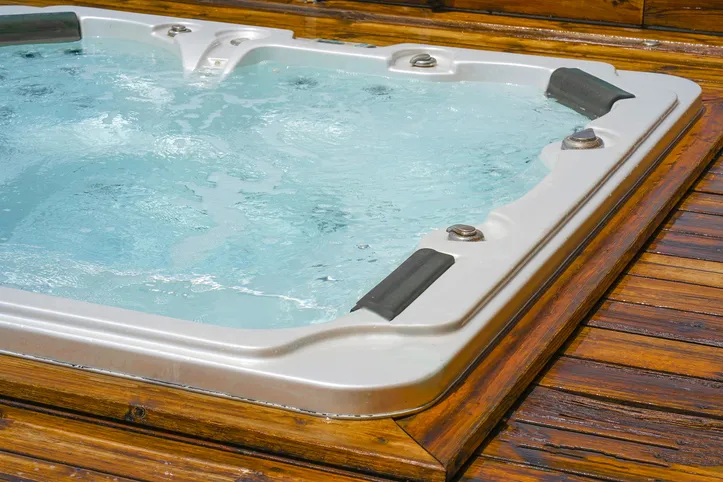Hot tubs are synonymous with relaxation, a soothing oasis of warm water that provides year-round comfort. While the allure of a hot tub is undeniable, concerns about energy consumption and cost often linger in the background. However, with the right knowledge and a few smart choices, you can enjoy the warmth of your hot tub without feeling the pinch in your wallet. Explore how to ensure your hot tub is energy efficient with these tips and insights that can save you money while indulging in the luxury of a warm soak.
Table of Contents
The Energy-Efficiency Challenge
Hot tubs are a delightful addition to any home, providing relaxation, stress relief, and health benefits. Yet, they are also known for their voracious appetite for energy. So, how can you strike a balance between comfort and cost savings? It all starts by understanding the factors that influence hot tub energy efficiency.
- Temperature Control: Maintaining the desired water temperature consumes the most energy. Hot tubs can be kept warm 24/7, but doing so can significantly increase energy bills.
- Insulation: The quality of insulation and the hot tub’s cover plays a crucial role in retaining heat and reducing energy consumption.
- Pump and Filtration Systems: Efficient pumps and filtration systems help circulate water, but they can also contribute to energy consumption if not optimized.
- Water Chemistry: Proper water chemistry maintenance ensures safe water and prevents excess energy usage due to pump and heater strain.
Tips for Hot Tub Energy Efficiency
Now that we’ve outlined the main factors influencing hot tub energy efficiency, let’s delve into practical tips to help you save money while enjoying your hot tub.
- Optimize Temperature Settings: Lower the thermostat when the hot tub is not in use or when you’re away for an extended period. Reducing the water temperature by a few degrees can save energy.
- Invest in a High-Quality Cover: A well-insulated cover is essential for retaining heat. Ensure your hot tub’s cover is in good condition, without cracks or gaps allowing heat escape.
- Use a Timer: Install a timer to control the hot tub’s heating cycle. Program it to heat the water before using the tub and lower the temperature during off-peak hours.
- Consider a Hot Tub Enclosure: Building an enclosure around your hot tub can provide extra insulation, reducing heat loss to the surrounding environment.
- Regular Maintenance: Keep the hot tub clean and well-maintained. A clean tub operates more efficiently, reducing strain on the pump and filtration system.
- Upgrade to Energy-Efficient Models: Consider upgrading to a newer, energy-efficient model if your hot tub is older. These models often come with advanced insulation, pumps, and filtration systems.
- Use a Windbreak: If your hot tub is exposed to strong winds, consider installing a windbreak or privacy screen to reduce heat loss through evaporation.
- Proper Water Chemistry: Maintain the correct water chemistry balance to reduce strain on the pump and heater. It prevents the need for extra energy to compensate for heat loss due to water evaporation.
- Regularly Replace Filters: Ensure the hot tub’s filtration system is clean and efficient by replacing filters according to the manufacturer’s recommendations.
Energy-Efficient Hot Tub Features
When shopping for a hot tub or considering an upgrade, watch for energy-efficient features that can significantly affect energy consumption.
- Insulation: Look for hot tubs with superior insulation materials and design. A well-insulated tub retains heat more effectively, reducing the need for constant reheating.
- Variable-Speed Pumps: Opt for hot tubs equipped with variable-speed pumps that allow you to adjust the pump’s speed and energy consumption based on usage and filtration needs.
- LED Lighting: LED lighting is energy-efficient and adds ambiance to your hot tub experience. It consumes significantly less energy than traditional lighting.
- Smart Controls: Some hot tubs come with smart control systems that allow you to adjust settings remotely, enabling you to heat the tub only when you plan to use it.
Think About Off-Peak Heating
If your electricity provider offers off-peak or time-of-use rates, take advantage of them to reduce your hot tub’s operating costs further. Time your hot tub’s heating cycles to coincide with lower electricity rates, often available during nighttime or early morning hours.
With the right approach to hot tub energy efficiency, you can enjoy the warmth and relaxation of your hot tub without dreading your energy bills. Many strategies are available, from optimizing temperature settings and investing in high-quality covers to upgrading to energy-efficient hot tubs and using off-peak heating. Remember that proper maintenance and water chemistry also play a significant role in reducing energy consumption. A well-maintained hot tub operates more efficiently, saving you money in the long run. So, go ahead and indulge in the cozy embrace of your hot tub this season. With energy-efficient practices in place, you can bask in the soothing warmth while also enjoying the savings in your pocket.



















